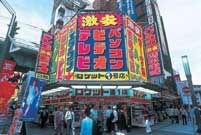Conversation
Conversation and Level 2
Tony : May I come in – Gomen kudasai
Kobayashi : Yes, who is that? – Hai, Dochira sama desu ka?
Tony : I’m Tony – Toni desu.
Kobayashi : Oh, Tony, welcome. Please come in – Maa, Toni-san, irasshaimase. Dōzo oagari kudasai.
Tony : Sorry for disturbing – Hai, ojama shimasu
John : Please (go in first) – Osaki ni dōzo
Tony : Thanks – Dōmo
Tony : Excuse me – Shitsurei shimasu
John : Excuse me – Shitsurei shimasu
Kobayashi : Please take a seat – Dōzo okake kudasai
Tony : Thank you – Hai, arigatō gozaimasu
Tony : This is John from America – Kochira wa amerika kara no Jon-san desu
John : I’m John, nice to meet you. – Hajimemashite. Jon desu
Kobayashi : I’m Kobayashi, nice to meet you. Regards – Kobayashi desu. Hajimemashite. Dōzo yoroshiku.
Meaning : Gomen Kudasai (May I come in), Dochira Sama (Who – polite form), Irrashaimase (Welcome), Oagari (Rise, Come In – polite form), Ojama (Disturb), Osaki (First), Dōzo (Please), Dōmo (Thanks), Shitsurei (Excuse), Okake (Sit Down), Kochira (This), Kochira (This – for human – polite form), Hajimemashite (Nice to meet you), Yoroshiku (This is something like “All the best” or asking someone for a favor)
 Akihabara, Tokyo’s world-famous Electric Town where you will find a wide range of comtemporary electric & electronic appliances at far cheaper prices than any where in Japan. If you have plan to go there, Akihara is a place where you shouldn’t miss this place.
Akihabara, Tokyo’s world-famous Electric Town where you will find a wide range of comtemporary electric & electronic appliances at far cheaper prices than any where in Japan. If you have plan to go there, Akihara is a place where you shouldn’t miss this place. Feedburner
Feedburner







